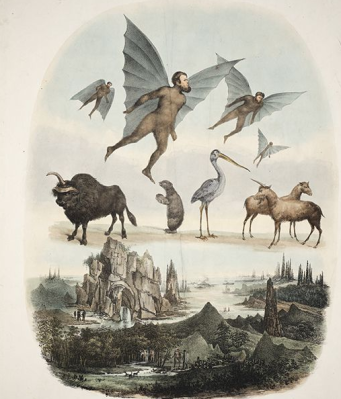Humans first walked on the moon 50 years ago, yet there are some people who don’t think it happened. This story is not about them. It turns out there was another great conspiracy theory involving a well-known astronomer, unicorns, and humanoids with bat wings. This one came 134 years before the words “We chose to go to the moon” were uttered.
The 1835 affair — known as the Great Moon Hoax — took the form of six articles published in The Sun, a newspaper in New York City. Think of it like “War of the Worlds” but in newspaper form — reported as if true but completely made up. Although well-known astronomer John Herschel was named in the story, he wasn’t actually involved in the hoax. Richard Adams Locke was the reporter who invented the story. His main goal seemed to be to sell newspapers, but he also may have been poking fun at some of the more outlandish scientific claims of the day.
A Telescope Beyond Belief and a Yarn Spun Out of This World
The first of the six articles touted that Sir John Herschel had made amazing discoveries at the Cape of Good Hope and that the articles originally appeared as a supplement to the Edinburgh Journal of Science. If you want to read the original, you can find the text at the Museum of Hoaxes. However, here’s a short summary: Supposedly, Herschel had created a huge telescope using a new principle, shipped it to South Africa, and had visualized many amazing things with it.
In the story, the new telescope was supposed to be a large tubeless reflector, although later they talk about a giant lens. The image formed was further magnified by a water drop microscope. We think. Keep in mind, the thing didn’t really exist, and the text is hard to parse so some of it could be Star Trek-style technobabble. We especially liked “hydro-oxygen microscope.” We were also amused that when Herschel and David Brewer came up with the idea, Brewer reportedly said — we aren’t making this up — “Thou art the man!” We guess things haven’t changed so much over the last 200 years.
The final instrument was said to have a 24-foot diameter, weigh almost 7 tons, and could magnify up to 42,000 times. Supposedly, the new telescope had found planets around other stars and could see objects on the moon as clearly as you’d see something with your own eyes one hundred yards away. And what did he supposedly see? At first, there were reports of red flowers. There were also a number of types of lunar trees that eventually gave way to a lake.
Like all good stories, there was a slow reveal. They found slender pyramids — surely the sign of intelligent life. Then they observed animals of various types. There was something like bison and one animal described as a “monster” resembling a goat.
By the fourth installment, the scientists observed winged humanoids that appeared to engage …read more
Source:: Hackaday

